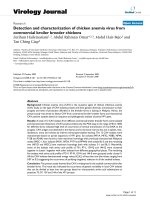Báo cáo hóa học: " Fabrication and characterization of carbon-based counter electrodes prepared by electrophoretic deposition for dye-sensitized solar cells" doc
Bạn đang xem bản rút gọn của tài liệu. Xem và tải ngay bản đầy đủ của tài liệu tại đây (1.08 MB, 4 trang )
NANO EXPRESS Open Access
Fabrication and characterization of carbon-based
counter electrodes prepared by electrophoretic
deposition for dye-sensitized solar cells
Hyunkook Kim, Hyonkwang Choi, Sookhyun Hwang, Youngjoo Kim and Minhyon Jeon
*
Abstract
Three different carbon-based counter electrodes are investigated in light of catalytic activities such as
electrochemical frequencies and interface impedances. We fabricated carbon-based counter electrodes of dye-
sensitized solar cells [DSSCs] using graphene, single-walled carbon nanotubes [SWNTs], and graphene-SWNT
composites by electrophoretic deposition method. We observed the optical and electrochemical properties of the
carbon-based counter electrodes. Th e DSSC with the graphene-deposited counter electrode demonstrated the best
conversion efficiency of 5.87% under AM 1.5 and 1 sun condition. It could be utilized for a low-cost and high-
throughput process for DSSCs.
Keywords: dye-sensitized solar cells, counter electrodes, graphene, single-walled carbon nanotubes, electrophoretic
deposition.
Introduction
Dye-sensitized solar cells [DSSCs] have emerged as the
next generation of photovoltaic devices, offering several
advantages, including moderate light-to-electricity conver-
sion efficiency, easy fabrication, and low cost [1-4]. Gener-
ally, a DSSC is composed of a mesoporous nanocrystalline
film (normally titanium oxide), to whose surface is
attached a monolayer of the charge-transfer dye molecule,
an electrolyte containing a dissolved iodide/tri-iodide
redox couple, and a counter electrode. The role of counter
electrodes is to transfer electrons from the external circuit
to the tri-iodide and iodine in the redox electrolyte [5].
Most commonly, Pt counter electrodes are utilized; how-
ever, despite their excellent properties, they suffer from
several limitations, e.g., difficulty in large-scale production
and high economic cost. Carbon nanomaterials provide a
promising alternative to Pt owing to their intrinsic attrac-
tive features, notably their high electrical conductivity, cor-
rosion resistance, and excellent electrocatalytic activity, as
well as their increasingly affordable cost.
The application of various carbon nanomaterials, such
as carbon blacks, carbon nanotubes, and graphenes, to
counter electrodes has been widely documented in the
literature [6-12]. We reported that chemically converted
graphene-based carbon nanocomposites and chemical-
vapor-deposited graphene-b ased carbon nanocomposites
had energy conversion efficiencies of 3.0% and 4.46%,
respectively. However, several difficulties such a s low
cost and mass production process have hampered the
realization of these materials as a coun ter electrode for
DSSCs [13,14].
In order to overcome those problems, we investigated
counter electrodes fabricated with three different carbon-
based materials such as graphene, single-walled c arbon
nanotubes [SWNTs], and graphene-SWNT composites
using electrophoretic deposition [EPD]. The EPD method
is an automated a nd high-throughput process that has
been widely employed in the industry; it can provide a
homogeneous and robust film o n the surface of the sub-
strate [15-17]. Herein, we present fabrication and charac-
terization results of counter electrodes of graphene,
SWNTs, and graphene-SWNT composites by the EPD
method using a dispersion solution of CNTs and graphene.
Experimental details
Graphenes were produced from graphite oxides, which
were synthesized using a modified Hummers’ method
* Correspondence:
Department of Nano Systems Engineering, Center for Nano Manufacturing,
Inje University, Gimhae, Gyungnam, 621-749, Republic of Korea
Kim et al. Nanoscale Research Letters 2012, 7:53
/>© 2012 Kim et al; licensee Springer. Thi s i s an Open Access article distributed under the terms of the Creative Commons Attribution
License ( which permits unrestricted use, distribution, and reproduction in any medium,
provided the original work is properly cited.
[18-20]. SWNTs were purchased from Hanwha Nano-
tech Corporation (Incheon, South Korea), which had a
diameter of 1.5 to 3 nm and a length of a few micro-
meters. Subsequently, an EPD solution was prepared to
deposit the graphenes, SWNTs, and carbon composites
on fluorine-doped tin oxide [FTO] substrates. Chemi-
cally converted graphenes, SWNTs, magnesium nitrate,
and ethanol were mixed together in an ultrasonicator
for several hours. The FTO glass (7 Ω·cm
-2
) and a stain-
less steel substrate were then immersed in the EPD
solution. The distance between the FTO and the stain-
less steel substrate was kept at 1 cm, and a voltage of 30
V was a pplied. The counter electrodes were annealed at
600°C for 1 min, after which they were gradually cooled
under nitrogen gas at ambient temperature.
AporousTiO
2
film was coated onto the FTO glass
using the doctor-b lade method; the fabricatio n was then
sintered at 450°C for 1 h, which resulted in a film thick-
ness of approximately 30 μm. The mesoporous TiO
2
film
was then immersed in a solution of the N-719 dye (Ruthe-
nizer 535-bisTBA, Solaronix, Aubonne, Switzerland) with
a concentration of 0.5 mmol/L in ethanol for a period of
36 h at room temperature. After that time, the TiO
2
elec-
trode and counter electrode were sandwiched with a n
appr oximately 60-μm-thick (before melting) surlyn pol y-
mer foil as a spacer and sealed by keeping the cell in a
hot-press at 110°C for 10 s. The liquid electrolyte (AN-50,
Solaronix) was injected through predrilled holes on the
counter electrode, which were next sealed by the surlyn
polymer foil and a cover glass.
The deposited SWNTs, graphenes, and carbon compo-
sit es were characterized by field-emission scanning elec-
tron microscopy [FE-SEM] and ultraviolet-visible
spectroscopy. The cells were illuminated using a solar
simulator (PEC-L01, Peccell Technologies, Inc., Yo ko-
hama, Kanagawa, Japan) under AM 1.5 (100 mW/cm
2
)
irradiation.Theenergyconversionefficiencyofthecells
was recorded by an electrochemical impedance analyzer
(Compacstat, Ivium Technologies, Fernandina Beach, FL,
USA). Electrochemical impedance spectroscopy measure-
ments were carried out with a bias illumination of 100
mW/cm
2
under an open-circuit condition and in a fre-
quency range of 0.1 Hz to 100 KHz.
Results and discussion
Figure1showstheFE-SEMimagesofdeposited(a)gra-
phenes, (b) SWNTs, and (c) graphene-SWNT composites
on the FTO substrates. Deposited graphenes (a) were
identified by their diff erent contrasts, and t hey showed
the presence of graphene wrinkles formed during the
EPD deposition. In the case of the SWNT electrode (b),
relatively thick SWNT layers were deposited onto the
substrates. Finally, the deposited graphene-SWNT
composite electrode (c) showed the simultaneous pre-
sence of graphene wrinkles and SWNTs.
The optical transmittance of the graphene, SWNT,
and carbon composite electrodes was then measured to
invest igate their potential for use as transparent counter
electrodes (Figure 2). The inset shows a photograph of
Figure 1 FE-SEM images.(a) Graphene-deposited FTO s ubstrate.
(b) SWNT-deposited FTO substrate. (c) Graphene-SWNT composite-
deposited FTO substrate.
Kim et al. Nanoscale Research Letters 2012, 7:53
/>Page 2 of 4
each counter electrode. In the visible range (at 550 nm),
transmi ttances of the graphene, SWNTs, and graphene-
SWNT composite electrodes were measured to be 62%,
70%, and 67%, respectively.
Subsequently, DSSCs were fa bricated using counter
electrodes with three different carbon-based materials
with the objective of evaluating the electrochemical
properties of the counter electrodes and the energy con-
version efficiencies of cells. Figure 3 shows the Bode
phase plots of the DSSCs with graphenes, SWNTs, and
graphene-SWNT composite counter electrodes. Since
the frequency peak in the high-frequency region in the
Bode phase plot is related to the charge transfer a t the
interfaces of ele ctrolyte/counter electro des, we only
focus on the characteristic peaks in this region. As can
be seen from the figure, redox frequencies on the gra-
phene, carbon nanocomposite, and SWNT counter elec-
trodes were measured to be 31.6, 6.3, and 2.5 KHz,
respectively.
The Nyquist plots of those three counter electrodes are
shown in Fi gure 4. A Nyquist plot typically contains two
or three semicircles: the first circle in the high-frequency
range is related to the interface between the electrolyte
and the counter electrode, whereas the second circle is
related to the TiO
2
/electrolyte interface. As shown in the
figure, the resistances (R
ct1
) between the electrolyte and
the graphenes, SWNTs, and carbon nanocomposite
counter electrodes of the DSSC were measured at 16.2,
35.3, and 17.6 Ω, respectively.
Figure 5 shows the current density-voltage characteris-
tics of the DSSCs with carbon nanomaterials. The redox
frequency [R
ct1
], open-circuit voltage [V
oc
], short-circuit
photocurrent density [J
sc
], fill factor [FF], and energy
conv ersion efficiency [h] are listed in Table 1. From the
values listed in the table, it can be said that graphene is
the most suitable material for a counter electrode, fol-
lowed by carbon nanocomposites and SWNTs.
Conclusion
In this report, we demonstrated the fabrication of carbon
nanomaterials deposited on FTO substrates by the EPD
method and their application as counter electrodes for
DSSCs. Our results provided evidence that graphene,
SWNTs, and graphene-SWNT composites could perform
sufficiently w ell as c ounter electrodes for DSSCs.
Figure 2 Transmittance spectra of carbon-based counter
electrodes. The inset shows different deposition materials: (a)
graphenes, (b) SWNTs, and (c) graphene-SWNT composites.
Figure 3 Bode phase plots of DSSC s. Bode phase plots of DSSCs
with different counter electrodes: graphenes (square), SWNTs (circle),
and graphene-SWNT composites (diamond).
Figure 4 NyquistplotofDSSCs. Nyquist plot of DSSCs with
different counter electrodes: graphenes (square), SWNTs (circle), and
graphene-SWNT composites (diamond).
Kim et al. Nanoscale Research Letters 2012, 7:53
/>Page 3 of 4
Comparison of the h and FF of the counter electrodes
with three different carbon-based materials measured
under similar deposition conditions of optical transmit-
tance showed that graphene is the most suitable material
for application as a counter electrode in DSSCs among
them. Based o n this finding, in the future, we intend to
conduct further studies for improving the performance of
graphene-based counter electrodes in order to realize
DSSCs with higher efficiency.
Acknowledgements
This work was supported by the Korea Industrial Technology Association
(KOITA).
Authors’ contributions
HK fabricated the cells and wrote the paper. HK and HC did the
characterization and imaging of the solar cells. SH and YK helped design the
experimental study and advised on the project. MJ developed the
conceptual framework and supervised the work. All authors read and
approved the final manuscript.
Competing interests
The authors declare that they have no competing interests.
Received: 8 September 2011 Accepted: 5 January 2012
Published: 5 January 2012
References
1. O’Regan B, Grätzel M: A low-cost, high-efficiency solar cell based on dye-
sensitized colloidal TiO
2
films. Nat 1990, 353:737-740.
2. Grätzel M: Dye-sensitized solar cells. J Photochem Photobiol C: Photochem
Rev 2003, 4:145-153.
3. Grätzel M: Photoelectrochemical cells. Nat 2001, 414:338-344.
4. Grätzel M: Solar energy conversion by dye-sensitized photovoltaic cells.
Inorg Chem 2005, 44:6841-6851.
5. Han J, Kim H, Kim DY, Jo SM, Jang S-Y: Water-soluble polyelectrolyte-
grafted multiwalled carbon nanotube thin films for efficient counter
electrode of dye-sensitized solar cells. ACS Nano 2010, 4 :3503-3509.
6. Ramasamy E, Lee WJ, Lee DY, Song JS: Spray coated multi-wall carbon
nanotube counter electrode for tri-iodide (I
3
-
) reduction in dye-
sensitized solar cells. Electrochem Commun 2008, 10:1087-1089.
7. Koo B-K, Lee D-Y, Kim H-J, Lee W-J, Song J-S, Kim H-J: Seasoning effect of
dye-sensitized solar cells with different counter electrodes. J Electroceram
2006, 17:79-82.
8. Choi H, Hwang S, Bae H, Kim S, Kim H, Jeon M: Electrophoretic graphene
for transparent counter electrodes in dye-sensitised solar cells. Electron
Lett 2011, 47:281-283.
9. Choi H, Kim H, Hwang S, Han Y, Jeon M: Graphene counter electrodes for
dye-sensitized solar cells prepared by electrophoretic deposition. J Mater
Chem 2011, 21:7548-7551.
10. Roy-Mayhew JD, Bozym DJ, Punckt C, Aksay IA: Functionalized graphene
as a catalytic counter electrode in dye-sensitized solar cells. ACS Nano
2010, 4:6203-6211.
11. Li P, Wu J, Lin J, Huang M, Huang Y, Li Q: High-performance and low
platinum loading Pt/carbon black counter electrode for dye-sensitized
solar cells. Solar Energy 2009, 83:845-849.
12. Halme J, Toivola M, Tolvanen A, Lund P: Charge transfer resistance of
spray deposited and compressed counter electrodes for dye-sensitized
nanoparticle solar cells on plastic substrates. Sol Energy Mater Sol Cells
2006, 90:872-886.
13. Choi H, Kim H, Hwang S, Choi W, Jeon M: Dye-sensitized solar cells using
graphene-based carbon nano composite as counter electrode. Sol Energy
Mater Sol Cells 2011, 95:323-325.
14. Choi H, Kim H, Hwang S, Kang M, Jung D-W, Jeon M: Electrochemical
electrodes of graphene-based carbon nanotubes grown by chemical
vapor deposition. Scr Mater 2011, 64:601-604.
15. Van der Biest OO, Vandeperre LJ: Electrophoretic deposition of materials.
Annu Rev Mater Sci 1999, 29:327-352.
16. Sarkar P, Nicholson PS: Electrophoretic deposition (EPD): mechanisms,
kinetics, and application to ceramics. J Am Ceram Soc 1996, 79:1987-2002.
17. Boccaccini AR, Cho J, Roether JA, Thomas BJC, Minay EJ, Shaffer MSP:
Electrophoretic deposition of carbon nanotubes. Carbon 2006,
44:3149-3160.
18. Hummers WS, Offeman RE: Preparation of graphitic oxide. J Am Chem Soc
1958, 80:1339.
19. Kovtyukhova NI, Ollivier PJ, Martin BR, Mallouk TE, Chizhik SA, Buzaneva EV,
Gorchinskiy AD: Layer-by-layer assembly of ultrathin composite films
from micron-sized graphite oxide sheets and polycations. Chem Mater
1999, 11:771-778.
20. Tung VC, Allen MJ, Yang Y, Kaner RB: High-throughput solution processing
of large-scale graphene. Nat Nanotech 2009, 4:25-29.
doi:10.1186/1556-276X-7-53
Cite this article as: Kim et al.: Fabrication and characterization of
carbon-based counter electrodes prepared by electrophoretic
deposition for dye-sensitized solar cells. Nanoscale Research Letters 2012
7:53.
Figure 5 J-V characteristics of DSSCs with different counter
electrodes.(a) Graphenes. (b) SWNTs. (c) Graphene-SWNT
composites.
Table 1 Experimental data of DSSCs with counter
electrodes of differential carbon-based materials
R
ct1
(Hz)
R
ct1
(Ω)
V
oc
(V)
J
sc
(mA/cm
2
)
FF
(%)
h
(%)
Graphenes 31, 600 16.212 0.7 13.1 63.6 5.87
SWNTs 2, 510 35.347 0.71 13.0 52.3 4.94
Composites 6, 310 17.631 0.7 12.7 56.5 5.17
R
ct1
, redox frequency; V
oc
, open-circuit voltage; J
sc
, short-circuit photocurrent
density; FF, fill factor; h, energy conversion efficiency; SWN Ts, single-walled
carbon nanotubes.
Kim et al. Nanoscale Research Letters 2012, 7:53
/>Page 4 of 4









